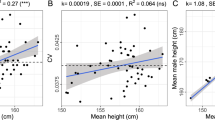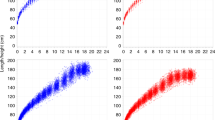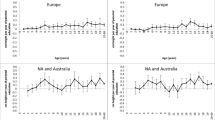Abstract
Background/Objectives:
Given the availability of large longitudinal data sets on human height and weight, different modelling approaches are at hand to access quantities of interest relating to important diagnostic aims.
Subjects/Methods:
Statistical modelling frameworks for longitudinal data on human height and weight have to consider the issues of individual heterogeneity and time dependence to provide an accurate statistical characterisation. Further, missing values inevitably occurring within longitudinal data sets have to be addressed adequately to allow for valid inference. The Bayesian framework is illustrated to facilitate stringent comparison of available non-nested model frameworks addressing these issues using simulated and empirical data sets.
Results:
Comparing random-effects and fixed-effects modelling approaches with the Preece–Baines (PB) model reveals that, for simulated data, the Bayesian approach towards model comparison is effective in discriminating between different model specifications. With regard to analysis of 14 longitudinal data sets, the implicit trade-off between model fit, that is, description of the data, and a parsimonious parameterisation favouring prediction is often best addressed via the PB model.
Conclusions:
The Bayesian approach is illustrated to allow for effective comparison in case model specifications for longitudinal data are not linked directly via parametric restrictions.
This is a preview of subscription content, access via your institution
Access options
Subscribe to this journal
Receive 12 print issues and online access
$259.00 per year
only $21.58 per issue
Buy this article
- Purchase on Springer Link
- Instant access to full article PDF
Prices may be subject to local taxes which are calculated during checkout
Similar content being viewed by others
References
WHO WHO Child Growth Standards: Length/Height-For-Age, Weight-For-Age, Weight-For-Length, Weight-For-Height and Body Mass Index-For-Age: Methods and Development. World Health Organization: Geneva, Switzerland, 2006.
Preece MA, Baines MJ . A new family of mathematical models describing the human growth curve. Ann Hum Biol 1978; 5: 1–24.
Jenss RM, Bayley N . A mathematical method for studying growth in children. Hum Biol 1937; 9: 556–563.
Cole TJ, Green PJ . Smoothing reference centile curves: the LMS method and penalized likelihood. Stat Med 1992; 11: 1305–1319.
Cole TJ, Donaldson, Malcolm DC, Ben-Shlomo Y . SITAR—a useful instrument for growth curve analysis. Int J Epidemiol 2010; 39: 1558–1566.
Kass RE, Raftery AE . Bayes factors. J Am Stat Assoc 1995; 90: 773–795.
Aßmann C, Hermanussen M . Modeling determinants of growth: evidence for a community-based target in height? Pediatr Res 2013; 74: 88–95.
Tanner MA, Wong WH . The calculation of posterior distributions by data augmentation. J Am Stat Assoc 1987; 82: 528–540.
Casella G, George EI . Explaining the Gibbs sampler. Am Stat 1992; 46: 167–174.
Chib S . Marginal likelihood from the Gibbs output. J Am Stat Assoc 1995; 90: 1313–1321.
Chib S, Jeliazkov I . Marginal likelihood from the Metropolis–Hastings output. J Am Stat Assoc 2001; 96: 270–281.
Author information
Authors and Affiliations
Corresponding author
Ethics declarations
Competing interests
The authors declare no conflict of interest.
Rights and permissions
About this article
Cite this article
Preising, M., Suchomlinov, A., Tutkuviene, J. et al. Modelling human height and weight: a Bayesian approach towards model comparison. Eur J Clin Nutr 70, 656–661 (2016). https://doi.org/10.1038/ejcn.2016.23
Received:
Accepted:
Published:
Issue Date:
DOI: https://doi.org/10.1038/ejcn.2016.23



